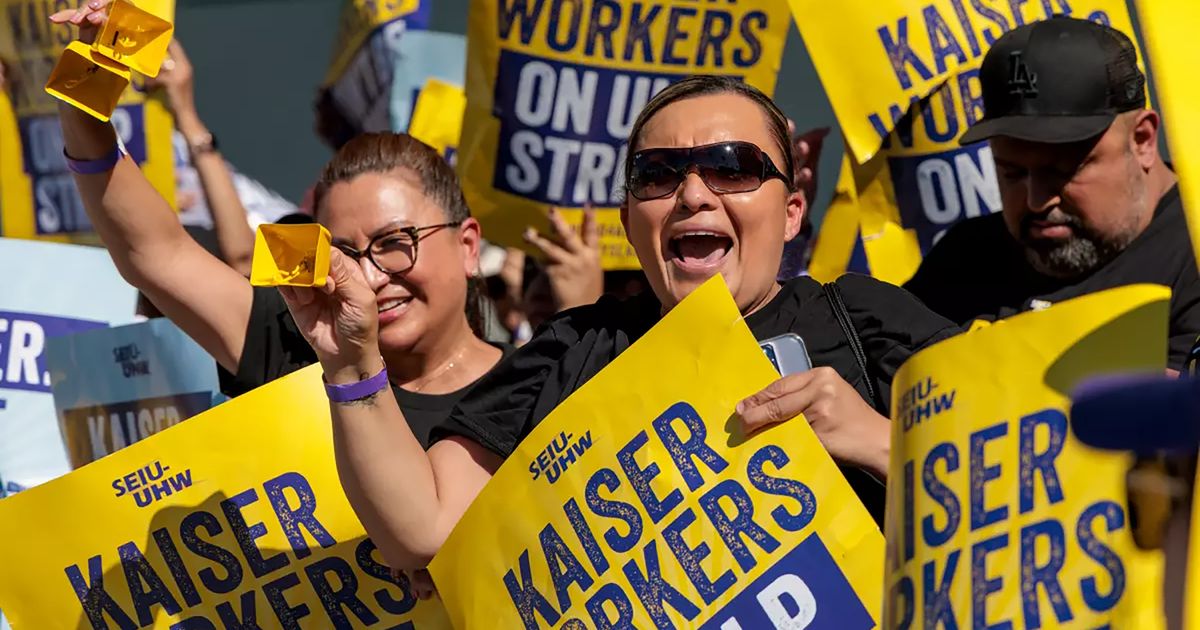The largest health care strike in U.S. history was called off Thursday as Kaiser Permanente and unions representing 75,000 workers finally reached a tentative agreement. This follows a planned three-day work stoppage by unions that has given their employers a preview of what will happen if the standoff continues. Kaiser clearly didn’t want to see more.
That’s good news for American workers, who were quick to feel the pinch from record high inflation but slow to reap the benefits of the record profits that came with it. According to the Bureau of Labor Statistics, since last August, we have seen 42 work stoppages of at least 1,000 employees nationwide. There is a theme here, which is that workers have been pushed too hard for too long as if the corporate brain believes “The Hunger Games” is a how-to book.
It’s not just that wages are rising slowly, and it’s not just that increases in housing and food prices have outstripped inflation. Look at the barriers we have created to ensure adequate child care.
As of late last month, states were facing the loss of $39 billion in federal funding for child care, a financial disaster that threatens the solvency of 70,000 programs, jobs for more than 200,000 workers and the care of more than 3 million children. .
“There was a child care crisis even before the pandemic,” said Sen. Patty Murray, D-Wash., said. Last month, she and other Senate Democrats introduced a bill to try to soften the blow of losing this aid. “This is an urgent economic priority at every level: Child care allows parents to work, businesses hire workers, and it is an investment in our children’s futures. The child care industry holds every sector of our economy.”
Before the pandemic, the Department of Health and Human Services reported that the amount of money families spent on child care was about 40% more than what was considered affordable. Combine that with the fact that this year’s average salary increased at the same pace as last year’s. And the reality is that the purchasing power gap caused by record inflation is forecast to last until the end of 2024.
What exactly are working parents supposed to do?
While many white-collar industries offer child care options, the fastest-growing leisure and hospitality work sector is not necessarily a leader in the field. In Germany, municipalities are required by law to provide childcare. In America, we are less permissive. Kind of like the “don’t have kids unless you can afford them” attitude.
The problem is that we lack people who are capable of raising children without help.
September marked the 33rd consecutive month that the US economy added jobs. Labor market participation rates have increased and there are more than 9 million job opportunities across the country. This is all great news unless you need childcare. Then you have to find out whether any job available to you pays more than what you spend on child care, assuming you’re not among the 50% of Americans who live in the so-called is a place that cares for abandoned children in areas of the United States where the number of pre-K bodies outnumbers the available number.
“It’s a never-ending financial and logistical burden for the whole family,” Murray said.
Choose Medicaid, welfare, Social Security conservatives have historically talked about entitlements and the safety net as if those on benefits are lazy and not part of the workforce. The reality of how inaccurate that assessment is is about to smack them in the face because of the connection between labor and child care.
These people would rather cut government programs than fund social services, but here’s the thing: If future workers can’t afford to work, then austerity will How to solve the problem?
When we talk about the work ethic of the “greatest generation,” we often leave out the part about the federal government stepping in and subsidizing the construction of child care centers and all. Without that assistance, most of the 6 million women who sustained this country during World War II would not have been able to enter the workforce.
By contrast, today, 68% of Oklahomans live in child care deserts. The state also estimates a shortage of 40,000 workers. Do you think it’s a coincidence?
The growth of the gig economy, combined with the passage of the Affordable Care Act, has created a path for more Americans to escape toxic work environments and become their own boss. theirs. The massive resignation and wave of labor strikes further highlighted the change in the relationship between labor and capital. However seismic those changes are, the biggest earthquake is yet to come. Paid family leave and affordable child care are no longer just items on liberals’ wish lists.
Like the rest of the industrialized world, America is slowly coming to grips with the reality that if you want people to work, the idea has to work for their children, too.
#policy #discourages #children #economy #paying #price
Image Source : www.seattletimes.com

